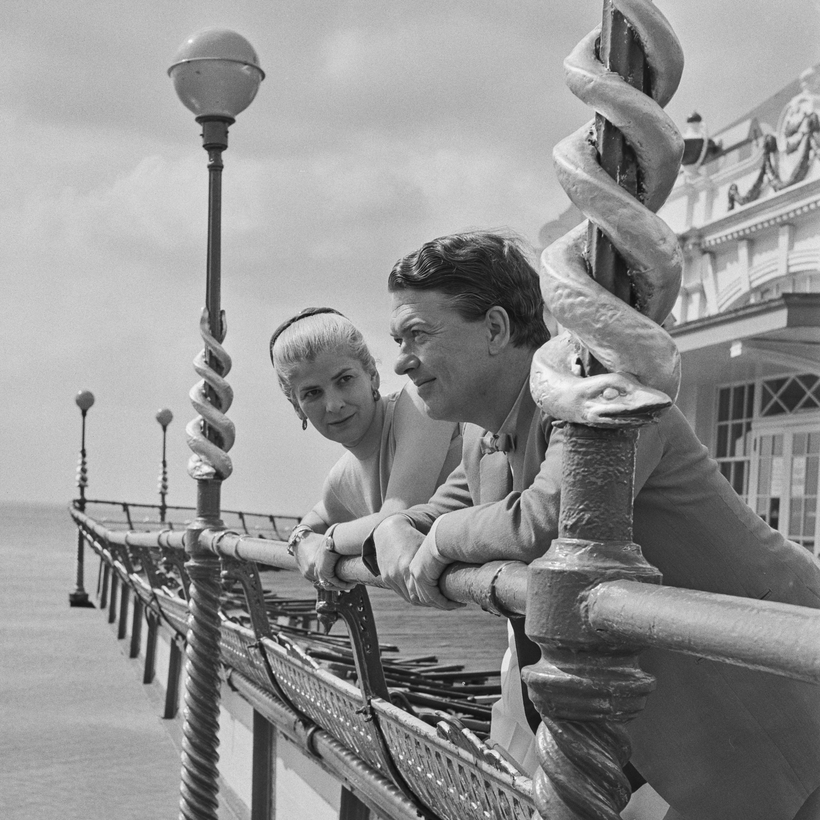Even before I opened Lives of the Wives: Five Literary Marriages, by Carmela Ciuraru, I had grave doubts about the viability of connubial life. I speak from limited experience, having been married once for four years and very quickly finding myself in agreement with the writer Stella Gibbons’s sentiment that marriage is one “long monotony.” There are couples who flourish within its confines, although I myself know many more who are resigned or who live with each other in a state of barely suppressed hostility. The fact that more than half of marriages end in divorce clearly points to a crack in its very foundation.
Ciuraru dissects a group of five 20th-century couples: Una Troubridge and Radclyffe Hall (both gay, they never married); Elsa Morante and Alberto Moravia; Elaine Dundy and Kenneth Tynan; Elizabeth Jane Howard and Kingsley Amis; and Patricia Neal and Roald Dahl. If marriages between ordinary mortals can be expected to face difficulties, the chances of things going awry multiply exponentially—mostly for the wives—when it comes to unions between writers. “In the marriages of celebrated literati throughout history, husband is to fame as wife is to footnote,” Ciuraru writes with axiomatic firmness.

Several of these relationships begin with obsession, and end in rancor. Not Troubridge and Hall’s partnership, however, which seemed the least interesting to me, in part because there was little overt conflict. Troubridge experienced a coup de foudre when she met Hall, and ever thereafter she considered it an honor to serve her talented partner—content (or so it appears) to leave her own considerable drawing and writing skills behind her. Troubridge edited Hall’s books (notably the pioneering lesbian novel The Well of Loneliness) with unfailing devotion, describing in her diary “a life of watching, serving and subordinating everything in existence to the requirements of an overwhelming literary inspiration and industry.”
Another exception is the union of Morante and Moravia, neither of whom seem especially smitten with the other; the usual kowtowing of a diffident literary wife to the acknowledged Male Genius does not transpire. Indeed, Morante accused Moravia of an “incurable detachment” and often humiliated him in public. As her longtime translator put it, “Elsa hated to be thought of as Mrs. Moravia.”

The remaining three marriages make for painful, even incendiary reading. Tynan was a high-stepping dandy—on the afternoon he met Dundy, he was wearing plum trousers, yellow socks, and a Mickey Mouse watch—possessed of a dagger-like wit, which he used to devastating effect as one of London’s most influential theater critics. Although Dundy, the author of the much-admired (and recently reissued) novel The Dud Avocado, was willing to subsume herself to Tynan—“Ken was my self-esteem … the sun around which I revolved”—their marriage eventually fell apart under the strain of Tynan’s provocative and occasionally violent behavior. Dundy recalls Tynan “leaving me unconscious on the bathroom floor with two black eyes and a broken nose,” but they continued to vacillate on the issue of divorce, with Tynan threatening suicide when Dundy served him with papers. In 1964 she succeeded in extricating herself for good.

Among the saddest of these marital histories is that of Elizabeth Jane Howard and Kingsley Amis. Howard was already a published writer and public figure when the insecure beauty met the married Amis in 1962 while hosting a TV panel on “Sex and Literature.” They set about having a passionate affair and married in the spring of 1965. The alcoholic Amis set about vigorously, even ruthlessly, pursuing his writing while Howard assumed all the household duties. (Her stepson Martin Amis credits her with propelling him away from teenage sloth into academic ambition.)
If marriages between ordinary mortals can be expected to face difficulties, the chances of things going awry multiply exponentially—mostly for the wives—when it comes to unions between writers.
During their 18-year marriage, Howard wrote three more novels and a collection of stories while Amis published nearly 20 books. His attitude toward her became dismissive rather than passionate. “Nobody finds responsible people entertaining or desirable,” she observed. The couple stopped sleeping in the same bed, Howard started seeing a therapist to alleviate her isolation and misery, and finally one morning she left for what was purportedly a visit to a health farm in Suffolk—Amis didn’t bother to look up from his paper—and never came back.
The marriage of the actress Patricia Neal and the children’s-book writer Roald Dahl is the most complex and tragic of all. Neither Dahl, who was 10 years older than the rising actress, nor Neal appears to have been enamored of the other, and both Dashiell Hammett and Leonard Bernstein tried to warn her off marrying him. All the same, they plighted their troth in the summer of 1953; Neal cried into her pillow on her wedding night despite its being one of exactly three times that Dahl told her he loved her.

Dahl tolerated Neal’s ambition as long as she also kept up her wifely duties and was duly admiring of his work. The couple had four children and Dahl was a devoted father; when a taxicab crashed into their son Theo’s stroller, hurling him 40 feet and damaging his brain, Roald tended to Theo with great attentiveness and together with a neurosurgeon and a hydraulic engineer helped to invent a clog-resistant shunt. His tenacity and refusal to be defeated by what life sprang on him came in handy in 1965, when Patricia suffered two strokes followed by a cerebral hemorrhage and awoke from her coma with aphasia, blurred vision, and partial paralysis. Dahl was determined to goad, bully, humiliate, and torment Neal into recovery.
Although his martinet approach took a toll—she thought of him as “Roald the slave driver, Roald the bastard … Roald the Rotten”—he succeeded in getting her back on her feet. She became a spokeswoman for other stroke victims and even went back to acting. Dahl, meanwhile, resumed his philandering and frequently lashed out at Neal. They divorced in 1983 when Neal was 57, shortly after she had crept into Dahl’s bed and whispered into his ear, “I wish you were dead. I wish something would kill you.” Never one to hesitate or harbor second thoughts, Roald bought her a one-way ticket to New York the very next day. Yet, in the end, Patricia saved some generous words for her husband in her autobiography, As I Am: “He truly saved me, and I will be forever grateful to him for that.’”
The rapidity with which some of these relationships descend from pleasure into pain is enough to make one wonder whether women with ambitions and careers of their own would do better remaining footloose and fancy-free, with occasional dips into heated romance. All the same, these five marriages are very different in the nature of their dysfunctionality and the manner in which a talented woman is subordinated to the talented man she chooses to marry; Ciuraru’s attempt to cluster them together strikes me as a bit forced. Still, the mixture of high gossip and granular detail makes for enthralling reading.

Daphne Merkin is the author of numerous books, including the memoir This Close to Happy: A Reckoning with Depression and the novels Enchantment and 22 Minutes of Unconditional Love


